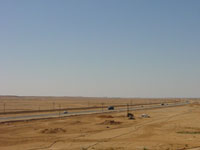Cities Built From Scratch in the Sand
 King Abdullah of Saudi Arabia plans to build six new cities over the next few decades to attract foreign investment, house a growing population and reduce his country’s reliance on oil revenues. The centerpiece is King Abdullah Economic City, a $27 billion real estate project 100 kilometres north of Jeddah on the Red Sea that will incorporate a number of ’green’ innovations.
King Abdullah of Saudi Arabia plans to build six new cities over the next few decades to attract foreign investment, house a growing population and reduce his country’s reliance on oil revenues. The centerpiece is King Abdullah Economic City, a $27 billion real estate project 100 kilometres north of Jeddah on the Red Sea that will incorporate a number of ’green’ innovations.The city will be spread over 173 square kilometres in the Arabian Desert, roughly the size of Washington D.C., when completed in 2020. Two million people will live in the newly-built metropolis and up to one million jobs will have been created in the process, according to Emaar The Economic City, the developer in charge of turning the king’s dream into reality.
The scale of the project is hard to fathom: Its sea port will have 30 container berths and be able to handle more than 10 million 20-foot container equivalent units each year. There will be 3.8 million square meters of office, retail and mix-use commercial space. Developers will build 150,000 apartments along with rows of townhouses and waterfront properties. And there will be a multi-university campus flanked by research and development parks. Two desalination plants will supply water to the population. A 120-story tower will include a photovoltaic exterior wall and wind towers that take advantage of winds from the Red Sea to generate energy.

This is good news for the country’s youth - 40 percent of Saudi Arabia’s population is under the age of 15 and the government wants to keep it satisfied by providing jobs and educational opportunities. If all goes according to plan, 10,000 housing units will be completed by 2010.
"The Saudi economy was in idle mode for 20 years," says John Sfakianakis, chief economist at Saudi bank SABB. "Today, the feeling here is, ‘We’ve won the lottery; let’s not waste it’," he tells The New York Times.
This modernization drive extends beyond King Abdullah Economic City. The 84-year-old monarch wants to finance five other metropolises: The Knowledge Economic City near Medina, the Prince AbdulAziz bin Mousaed Economic City in Hail and Jazan Economic City in the southwest. Two other towns are due to be announced.
The cities are expected to add $150 billion to the country’s GDP by 2020, according to the New York Times. All are expected to focus on four industrial sectors: petrochemicals, aluminum, steel and fertilizers.
Saudi Arabia is flush with money. Even after the current drop in the price of oil, some analysts believe cash reserves are plentiful enough to allow the country to transform itself into an industrial powerhouse. Especially since Saudi Arabia’s current budget is based on a price prediction of 50 dollars a barrel for oil. Other analysts disagree. They fear the country’s draconian investment rules and tightly regulated bureaucracy will slow the flow of foreign investors and transform the cities into white elephants.
"If oil stays high at above $70 a barrel then strong investment will continue, but if it falls below $50 then attracting foreign investment outside the energy sector becomes more challenging," says Brad Bourland, chief economist at Jadwa Investments, a Saudi-based investment bank, during an interview with the Gulf Times. This may be a concern since the price of oil today is a far cry from its high of $147 a barrel in July.
Another concern is that Saudi banks and the government have not yet publicly disclosed how much of their investments have been exposed to the current global financial meltdown. Regardless, the government of Saudi Arabia will want to preserve the momentum to build these cities. It knows oil revenues alone cannot sustain its booming population eager for good jobs and decent housing. The government wants stability and for now, this means transforming the country into an industrial giant.
The new city initiatives in Saudi Arabia are part of a region wide building boom that is giving rise to some of the most creative and impressive building designs ever imagined. As noted in an earlier GLOBE-Net article - breathtaking in their majesty, awesome in their vision, these designs could well be the portent of what cities of the future will look like. See New models of sustainability in the Middle East.
For more information: King Abdullah Economic City, Jazan Economic City
For More Information: New York Times
Source 2: BBC News
You can return to the main Market News page, or press the Back button on your browser.

